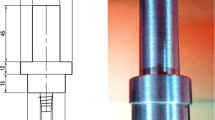Abstract
The variation of forces, torque, absorbed energy, and temperature distribution during friction stir welding process is investigated. Friction stir welding experiments were performed on an aluminum Al-Si-Mg alloy varying the tool rotation speed and the welding speed. An instrumented milling machine equipped with 3-axis load cell was adopted to measure the forces during the process. Temperature measurements were performed by means of an IR camera. A significant increase in temperature was observed during the process due to a “process preheating effect.” This resulted in the variation of the main forces. Phenomenological models were developed to describe these trends. The results indicated that processing conditions involving higher energy produced higher variation of temperature during the process, up to 2.3 °C mm−1.
Similar content being viewed by others
References
Bhattacharya TK, Das H, Jana SS, Pal TK (2016) Numerical and experimental investigation of thermal history, material flow and mechanical properties of friction stir welded aluminium alloy to DHP copper dissimilar joint. Int J Adv Manuf Technol 88(1–4):847–861
Long T, Tang W, Reynolds AP (2013) Process response parameter relationships in aluminium alloy friction stir welds. Sci Technol Weld Join 12(4):311–317
Das H, Basak S, Das G, Pal TK (2012) Influence of energy induced from processing parameters on the mechanical properties of friction stir welded lap joint of aluminum to coated steel sheet. Int J Adv Manuf Technol 64(9–12):1653–1661
Zimmer S, Langlois L, Laye J, Bigot R (2009) Experimental investigation of the influence of the FSW plunge processing parameters on the maximum generated force and torque. Int J Adv Manuf Technol 47(1–4):201–215
Su H, Wu CS, Pittner A, Rethmeier M (2013) Simultaneous measurement of tool torque, traverse force and axial force in friction stir welding. J Manuf Process 15(4):495–500
Jonckheere C, de Meester B, Denquin A, Simar A (2013) Torque, temperature and hardening precipitation evolution in dissimilar friction stir welds between 6061-T6 and 2014-T6 aluminum alloys. J Mater Process Technol 213(6):826–837
Longhurst WR, Strauss AM, Cook GE, Fleming PA (2010) Torque control of friction stir welding for manufacturing and automation. Int J Adv Manuf Technol 51(9–12):905–913
Cui S, Chen ZW, Robson JD (2010) A model relating tool torque and its associated power and specific energy to rotation and forward speeds during friction stir welding/processing. Int J Mach Tools Manuf 50(12):1023–1030
Manvatkar VD (2012) Neural network models of peak temperature, torque, traverse force, bending stress and maximum shear stress during friction stir welding. Sci Technol Weld Join
Yi D, Onuma T, Mironov S, Sato YS, Kokawa H (2016) Evaluation of heat input during friction stir welding of aluminium alloys. Sci Technol Weld Join 22(1):41–46
Vignesh RV, Padmanaban R, Arivarasu M, Thirumalini S, Gokulachandran J, Ram MSSS (2016) Numerical modelling of thermal phenomenon in friction stir welding of aluminum plates. IOP Conf Ser Mater Sci Eng 149:012208
Zhu XK, Chao YJ (2004) Numerical simulation of transient temperature and residual stresses in friction stir welding of 304L stainless steel. J Mater Process Technol 146(2):263–272
El-Sayed MM, Shash AY, Abd Rabou M (2017) Heat transfer simulation and effect of tool pin profile and rotational speed on mechanical properties of friction stir welded AA5083-O. J Weld Join 35(3):35–43
Khandkar MZH, Khan JA, Reynolds AP (2013) Prediction of temperature distribution and thermal history during friction stir welding: input torque based model. Sci Technol Weld Join 8(3):165–174
El-Sayed MM, Shash AY, Abd-Rabou M (2018) Finite element modeling of aluminum alloy AA5083-O friction stir welding process. J Mater Process Technol 252:13–24
Meyghani B, Awang M, Emamian S, Khalid NM (2017) Developing a finite element model for thermal analysis of friction stir welding by calculating temperature dependent friction coefficient.107-126
Su H, Wu CS, Pittner A, Rethmeier M (2014) Thermal energy generation and distribution in friction stir welding of aluminum alloys. Energy 77:720–731
Sedmak A, Kumar R, Chattopadhyaya S, Hloch S, Tadic S, Djurdjevic A, Cekovic I, Donceva E (2016) Heat input effect of friction stir welding on aluminium alloy AA 6061-T6 welded joint. Therm Sci 20(2):637–641
Lambiase F, Genna S, Leone C, Paoletti A (2017) Laser-assisted direct-joining of carbon fibre reinforced plastic with thermosetting matrix to polycarbonate sheets. Opt Laser Technol 94:45–58
Assidi M, Fourment L, Guerdoux S, Nelson T (2010) Friction model for friction stir welding process simulation: calibrations from welding experiments. Int J Mach Tools Manuf 50(2):143–155
Ulysse P (2002) Three-dimensional modeling of the friction stir-welding process. Machin Tools Manuf 42:1549–1557
Reynolds AP, Tang W, Khandkar Z, Khan JA, Lindner K (2013) Relationships between weld parameters, hardness distribution and temperature history in alloy 7050 friction stir welds. Sci Technol Weld Join 10(2):190–199
Author information
Authors and Affiliations
Corresponding author
Rights and permissions
About this article
Cite this article
Lambiase, F., Paoletti, A. & Di Ilio, A. Forces and temperature variation during friction stir welding of aluminum alloy AA6082-T6. Int J Adv Manuf Technol 99, 337–346 (2018). https://doi.org/10.1007/s00170-018-2524-6
Received:
Accepted:
Published:
Issue Date:
DOI: https://doi.org/10.1007/s00170-018-2524-6




